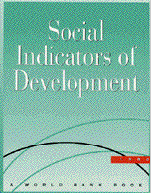
 World Bank
World Bank
 World Bank
World Bank
World Bank staff review the social indicators for reliability and validity. However, users should bear in mind that the concepts, definitions and methodology underlying indicators vary, sometimes significantly, from country to country and over time within countries. The data also reflect differences in the way information is collected and how perceptions change. While indicators reported are considered useful for identifying broad trends and differences, little significance should be attached to minor differences among indicators.
Few social indicators are collected annually--and social changes tend to occur slowly. Hence, the indicators refer to somewhat different dates within three broad time spans: 25-30 years ago (centering on 1965), 15-20 years ago (centering on 1975) and most recent estimates (1985 in most cases but 1990 for GNP per capita and population).
Emphasis in this publication is on country-by-country review. Up to 94 indicators are reported for each country including: size, growth, and structure of population; determinants of population growth (including data on fertility and infant mortality); labor force; education and illiteracy; natural resources; income and poverty; expenditure on food, housing, fuel and power, transport and communication; and investment in medical care and education. Each of these indicators is broken into several subcategories.
Data for each indicator in the country tables can be compared with the same measures for each of three reference groups: the income category in which the economy is classified, the next higher income category, and the geographic or regional group. International comparisons are made easier by separate tables on social and economic conditions that take a cross-country look at a limited number of indicators.
SID is issued annually in diskette as well as book form. Data in the book are presented for three time periods: the mid-sixties, the mid-seventies, and the most recent estimate (1985 or 1990). Diskettes contain time series data for 1965-93.
The 1995 edition of this annual statistical compilation is available in print, on diskette and on CD-ROM titled WORLD*DATA 1995. Access is available via the World Bank's Public Information Center.
Access to Social Indicators of Development database is available through a World Wide Web search interface.
For additional ordering information:
tel: (202)473-1155 or
WWW: How to Order World Bank Publications
WWW: World Bank Bookstore
email: books@worldbank.org